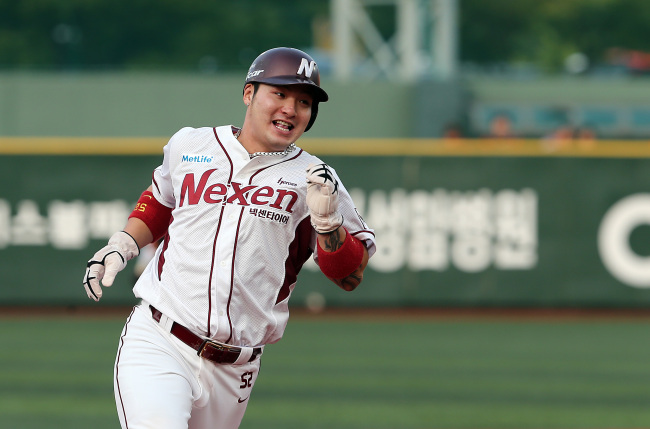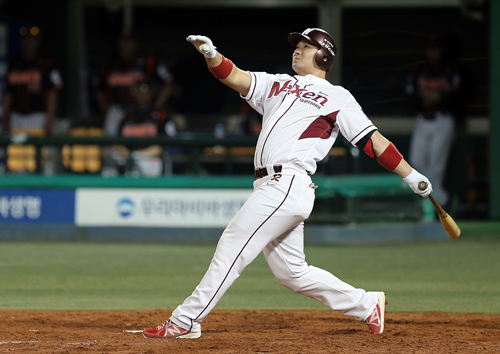- California Assembly OKs highest minimum wage in nation
- S. Korea unveils first graphic cigarette warnings
- US joins with South Korea, Japan in bid to deter North Korea
- LPGA golfer Chun In-gee finally back in action
- S. Korea won’t be top seed in final World Cup qualification round
- US men’s soccer misses 2nd straight Olympics
- US back on track in qualifying with 4-0 win over Guatemala
- High-intensity workout injuries spawn cottage industry
- CDC expands range of Zika mosquitoes into parts of Northeast
- Who knew? ‘The Walking Dead’ is helping families connect
Back-to-back 50 HR seasons? Don’t buy into the hype of Park Byung-ho just yet
By Brian Han
Pittsburgh Pirates shortstop Kang Jung-ho is the first piece of evidence that position players from the Korean Baseball Organization’s (KBO) elite can hang in the major leagues. Believe it or not, he’s the first to ever make this type of transition, and he’s setting a favorable precedent.
(Players like Ryu Hyun-jin and Choo Shin-soo have shown they are perfectly capable of competing at the highest level, but the former is excluded as a pitcher, and the latter was brought up in the minor league system here. Choo was also originally signed as a pitcher.)
The 28-year-old rookie posted a slash line of .287/.355/.461 with 15 home runs and 58 RBIs in 125 games, but his season was woefully cut short after a gruesome collision at second base.
The types of numbers he put up make his four-year $11 million deal seem like a steal for the Pirates, and other teams are undoubtedly searching for a similar deal.
It’s no wonder that scouts are keeping an eye on his former teammate Park Byung-ho who is currently tearing up the KBO with a .350/.442/.721 slash line. Even more impressive is the fact that he just became the first player to hit at least 50 home runs in back-to-back seasons.
In 2014, the 6-foot-1 236 pound slugger hit 52 home runs and 124 RBIs in 128 games. He will most certainly exceed those numbers in 2015 especially after the league extended the regular season from 128 to 144 games.
Any of his highlight reels illustrate that he can hit with power to both sides of the field.
Compared to Kang who used to sport an almost theatrical leg kick before laying into a pitch, Park has a nice compact swing although it usually ends in a dramatic finish with a bat flip that would not be well received by any MLB pitcher.
If defense was ever a concern, rest assured that in the same year Park won the KBO MVP in 2012, he also won the Gold Glove.
With that said, there is cause for concern. Kang was seen as incredibly valuable because he could mash the ball as a shortstop — a position that is typically devoid of offensive ability. Park is a first baseman, and first basemen are expected to bring some serious firepower to the plate.
If you compare the numbers Park has put up in the KBO straight up against his MLB counterparts, there is no question that he would be a welcome addition to any club. But that would make very little sense considering the average pitching, fielding and hitting capabilities of major league players are a notch above those of any other league in the world.
The first step is to see how Kang’s numbers translated to his first season as a Pittsburgh Pirates. Granted it is a small sample size, but it’s at least something.
Of the nine years Kang played in South Korea, he had six full seasons where he had at least 400 at-bats. Over that period of time, he hit .309 and averaged 22 home runs with 83 RBIs. It should be noted in his final season he put up some monstrous numbers including a .356 average, 40 home runs and 117 RBIs.
He ended his 2015 season numbers with a .287 average with 15 home runs and 58 RBIs in 421 at-bats — approximately the amount he averaged in the KBO, if not slightly less.
Across the board there are drops in each offensive category, which is completely understandable considering the level of play is higher in the MLB.
Park is a year older than Kang and despite beginning his KBO career in 2005, he’s only really put up elite numbers in his last three seasons. Before that point, the first baseman put up some lackluster performances including a .221 average from 2005 to 2011.
Over the same six seasons as Kang’s teammate, the 29-year-old hit .279 with an average of 27 home runs and 73 RBIs.
Using Kang’s transitional numbers as a guide, if Park was to put up slightly higher numbers, those numbers would be more than acceptable for a middle infielder, but for a first baseman they may not even qualify him as a starter on a major league team.
The median batting average for a 2014 MLB first baseman with at least 450 at-bats was .272 held by Albert Pujols of the Los Angeles Angels.
Even the worst of the bunch, Chris Davis with a .196 average, had 27 home runs and 72 RBIs in 2014 and he’s leading the position with 43 home runs in 2015.
Kang entered the league knowing that if he did half of what he did over in South Korea, he still would be valuable. For Park, that luxury doesn’t really exist. He’ll be 30 by the time he gets here so it’s very much a sink or swim situation assuming that an MLB club ends up signing him.
Park is steadily improving at the plate, and he’s putting up video game numbers in the KBO at the moment. But whereas Kang showed consistency throughout his career, Park took a little longer to adjust and peak.
Don’t be surprised to see him in an MLB jersey come 2016, but keep in mind that the measuring stick is completely different for Park.

















